#less on mythology and symbolism
Explore tagged Tumblr posts
Text






horizon + animorphs dossier [ battle morph || bird of prey || personal ]
— Horizon Forbidden West PC | part 1
#horizon forbidden west#hfw#hfwedit#horizonedit#horizonsource#usergif#videogamedaily#dailyvideogames#animorphs#mine*gif#hfw npc edition#this time forms were chosen based almost purely on vibes#less on mythology and symbolism#i've decided to split the npcs into 2 posts of 6 each so i don't kill computers lmao so this is animorphs part 2 of 3#(possibly 4 if i do the hzd-only set)#as always: you are welcome to make your own set if you have different ideas but do not start arguments on mine thanks#once again ty cor for some brainstorming
82 notes
·
View notes
Text
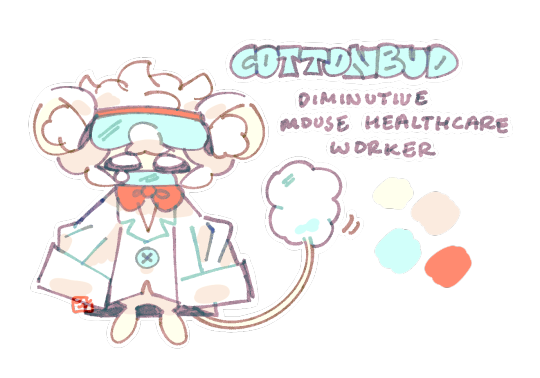
fuck it. plaguesona
#i thought of this a couple weeks ago on the bus a couple seats away from someone loudly coughing into the open air#i think something snapped and i decided to make a fuckin. medieval ass plague sona. horseman of pestilence fursona#this is also why i was asking abt animals with medical symbolism.. originally i wanted a two headed snake like the staff of caduceus#but it turns out thats actually hermes symbol. the real symbol for medicine is the rod of asclepius which looks pretty similar#the difference is that theres only one snake and its twined around a stick. ironically mercy from overwatch's weapons are named after#the caduceus despite the misconception LMAOOO#snakes were the most consistent medicine related animal i could find even across multiple cultures so it couldve really worked#if i could actually draw scalies.. one of my earliest sketches had a cobra with a syringe at the end of its tail like a rattlesnake#and it had markings similar to the syringe tube but i didnt have much else going on so i scrapped it#i was also recommended animals with less obvious ties to medicine like jellyfish and horseshoe crabs and learned something new ^_^#im not confident i could pull off a non-mammal furry but they were really good ideas i might put into smth else.. i also thought of#axolotls bc of their regenerative thing and growing back limbs but i think that would suit smth like a surgeon or amputation...#possums and bats were also an option bc theyre actually really resistant to most diseases like rabies but i feel like ppl wouldnt know that#if they saw it so it looks a little ironic at a glance. rabbits rats and mice were my second option bc of animal testing and lab rats#less obvious reference but the moon rabbit in chinese mythology is loosely connected to medicine bc it makes the elixir of life#otherwise lab mice in a pharmacy / modern medicine setting seemed fitting and jerboa tails remind me of cotton buds#and. ironically. jerboas are more closely related to elephants than rats and mice. can you believe it#my art#myart#my oc#sona#plaguesona#cottonbud#fur#furry art#character design#ref sheet#oc ref sheet
131 notes
·
View notes
Text
The thing with the Mari Lwyd, though, is that it's being... I don't know, 'appropriated' is the wrong word, but certainly turned into something it isn't.
Thing is, this is a folk tradition in the Welsh language, and that's the most important aspect of it. I feel partly responsible for this, because I accidentally became a bit of an expert on the topic of the Mari Lwyd in a post that escaped Tumblr containment, and I clearly didn't stress it strongly enough there (in my defence, I wrote that post for ten likes and some attention); but this is a Welsh language tradition, conducted in Welsh, using Welsh language poetic forms that are older than the entire English language, and also a very specific sung melody (with a very specific first verse; that's Cân y Fari). It is not actually a 'rap battle'. It's not a recited poem. It is not any old rhyme scheme however you want.
It is not in English.
Given the extensive and frankly ongoing attempts by England to wipe out Welsh, and its attendant cultural traditions, the Mari is being revived across Wales as an act of linguistic-cultural defiance. She's a symbol of Welsh language culture, specifically; an icon to remind that we are a distinct people, with our own culture and traditions, and in spite of everyone and everything, we're still here. Separating her from that by removing the Welsh is, to put it mildly, wildly disrespectful.
...but it IS what I'm increasingly seeing, both online and in real world Mari Lwyd festivals. She's gained enormous pop-culture popularity in recent years, which is fantastic; but she's also been reduced from the tradition to just an aesthetic now.
So many people are talking/drawing about her as though she's a cryptid or a mythological figure, rather than the folk practice of shoving a skull on a stick and pretending to be a naughty horse for cheese and drunken larks. And I get it! It's an intriguing visual! Some of the artwork is great! But this is not what she is. She's not a Krampus equivalent for your Dark Christmas aesthetic.
I see people writing their own version of the pwnco (though never called the pwnco; almost always called some variant on 'Mari Lwyd rap battle'), and as fun as these are, they are never even written in the meter and poetic rules of Cân y Fari, much less in Welsh, and they never conclude with the promise to behave before letting the Mari into the house. The pwnco is the central part to the tradition; this is the Welsh language part, the bit that's important and matters.
Mari Lwyd festivals are increasingly just English wassail festivals with a Mari or two present. The Swansea one last weekend didn't even include a Mari trying to break into a building (insert Shrek meme); there was no pwnco at all. Even in the Chepstow ones, they didn't do actual Cân y Fari; just a couple of recited verses. Instead, the Maris are just an aesthetic, a way to make it look a bit more Welsh, without having to commit to the unfashionable inconvenience of actually including Welsh.
And I don't really know what the answers are to these. I can tell you what I'd like - I'd like art to include the Welsh somewhere, maybe incorporating the first line of Cân y Fari like this one did, to keep it connected to the actual Welsh tradition (or other Welsh, if other phrases are preferred). I'd like people who want to write their version of the pwnco to respect the actual tradition of it by using Cân y Fari's meter and rhyme scheme, finishing with the promise to behave, and actually calling it the pwnco rather than a rap battle (and preferably in Welsh, though I do understand that's not always possible lol). I'd like to see the festivals actually observe the tradition, and include a link on the booking website to an audio clip of Cân y Fari and the words to the first verse, so attendees who want to can learn it ahead of time. I don't know how feasible any of that is, of course! But that's what I'd like to see.
I don't know. This is rambly. But it's something I've been thinking about - and increasingly nettled by - for a while. There's was something so affirming and wonderful at first about seeing the Mari's climb into international recognition, but it's very much turned to dismay by now, because she's important to my endangered culture and yet that's the part that everyone apparently wants to drop for being too awkward and ruining the aesthetic. It's very frustrating.
11K notes
·
View notes
Note
Could you do a criminal minds x reader where reader is viewed as super sweet and dresses brighter and stuff like Penelope but one day they have to come in like super late/by surprise so everyone is in their normal clothes and the bau sees that reader has a big ass, super cool tattoo? And they’re all surprised and stuff
You're looking less-than professional in your backless halter top when you take your seat at the round table, but no one bats an eye until you stand from the chair to leave. Hotch's call of 'Wheels up in 20' means that the room clears as everyone hunts for their gobags, and the second you turn your back to your coworkers a litany of reactions fill the space.
Of course, the most dramatic is from Garcia, but you hear enough to count all of your coworkers, except one. Hotch's brows are raised when you turn back to see them, though - apparently he's not above being startled.
"Woah, hot stuff," Prentiss calls, a grin spreading over her face, "You've got some nice ink back there!"
"I didn't know you had tattoos," JJ muses, staring at you with curious amusement like she's recalculating your image in her mind, "That's really intricate. I like it."
"Oh, it's-" You reach a hand up to stroke awkwardly over the inked skin, "I kind of forgot you'd never seen it before."
"Turn around again!" Garcia gushes, "I wanna look at it."
You spin on command, and Hotch and Rossi are kind enough not to gawp with the others, passing you on their way to the door.
"You've got guts, kid," Rossi grimaces, "I've been in a lot of pain before, but I don't know if I'd willingly sit there for all of that."
"I wouldn't," Hotch shakes his head with a good-natured smile, "Haley and I got small, matching ones in college, and I had a hard time with that one."
"Is that based off of Norse mythology?" Spencer pokes his head around your shoulder to stare bright-eyed at you, "Some of the symbols remind me of-"
"It's just a sick-ass tattoo, Reid." Morgan shoves at his shoulder. peering avidly at the art, "Don't ruin this for everyone."
Reid takes the shove like a champion, smiling kindly, albeit awkwardly at you as he moves for the door himself, "I like it."
"Thanks, Reid," You call, flinching slightly as a hand traces one of the symbols on your back.
"Ooh! Sorry, pumpkin," Garcia calls, the hand drawn away in a flash, "I got too grabby. I just think it's really cool," she takes your hand, leading you towards the door while the others follow to continue staring at your tattoo, "I'd show you my own body art, but it's not really in a spot that I can display in the workplace."
"Well this I've gotta see," Morgan teases, "Let's all huddle in the bathroom on the jet, babygirl, and see what you're hiding."
"It is not for your eyes, Derek Morgan," She huffs, though she's grinning at his attempt. The look in her eyes suggests that the tattoo is not for his eyes because it's something to do with him, and you're eager to giggle over whatever part of her body she's tatted 'babygirl' over later.
For now, though, you rifle through your gobag and shrug on a cardigan, effectively covering your back and its ink.
"It is a crying shame to cover up that artwork," Prentiss laments, "I bet it looks awesome peeking over tank tops."
"You'll see it again at the hotel," You laugh, "I have plans to use the jacuzzi before we leave."
"A jacuzzi sounds fantastic," JJ sighs, "But let's all of us agree that Morgan isn't invited - I wanna see Garcia's tattoo."
#bau x reader#criminal minds x reader#spencer reid x reader#aaron hotchner x reader#jennifer jareau x reader#emily prentiss x reader#derek morgan x reader#penelope garcia x reader#david rossi x reader
4K notes
·
View notes
Text
some times i look at terf blogs just curious about wtf kind of Drama is going on cause "radfem" tumblr is constantly exploding when one of their buddies turns out to be a horrible person.............in a way that affects them personally
Like last time there was a whole thing over a woman needing funds for an abortion and getting harassed by other "radfems" over it because "she chose to have sex with a man"
now some person is saying that although all men are bad, white men are inherently safer and less violent than men of color, and a bunch of people are defending them and its a total shit show
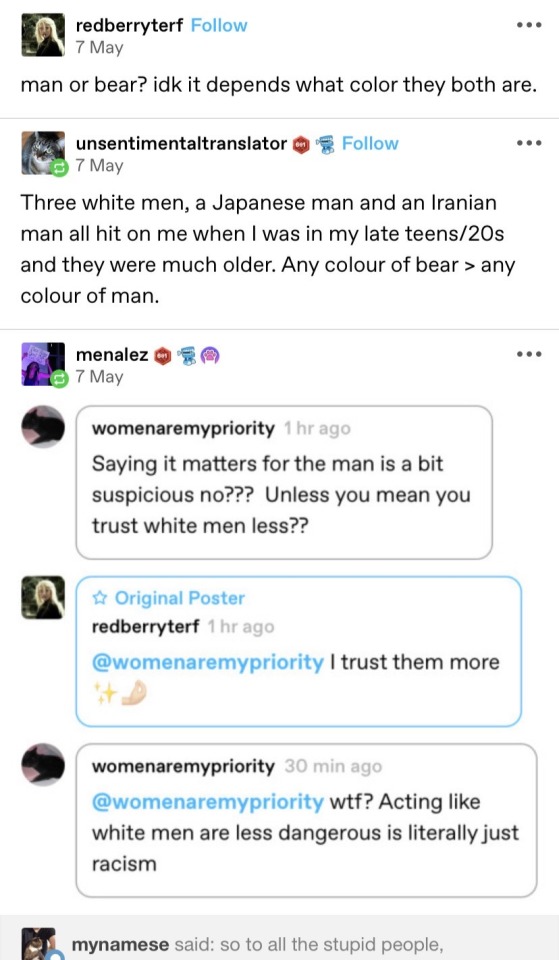
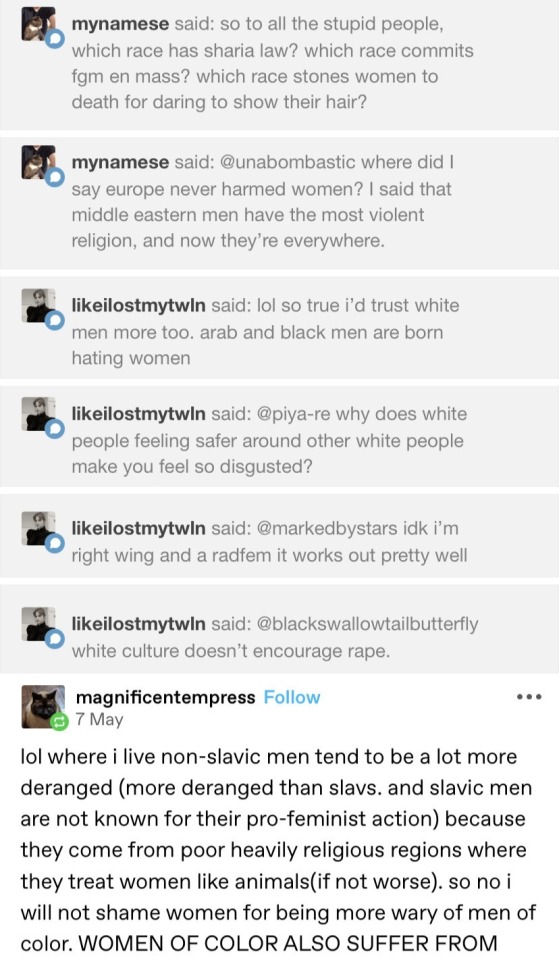


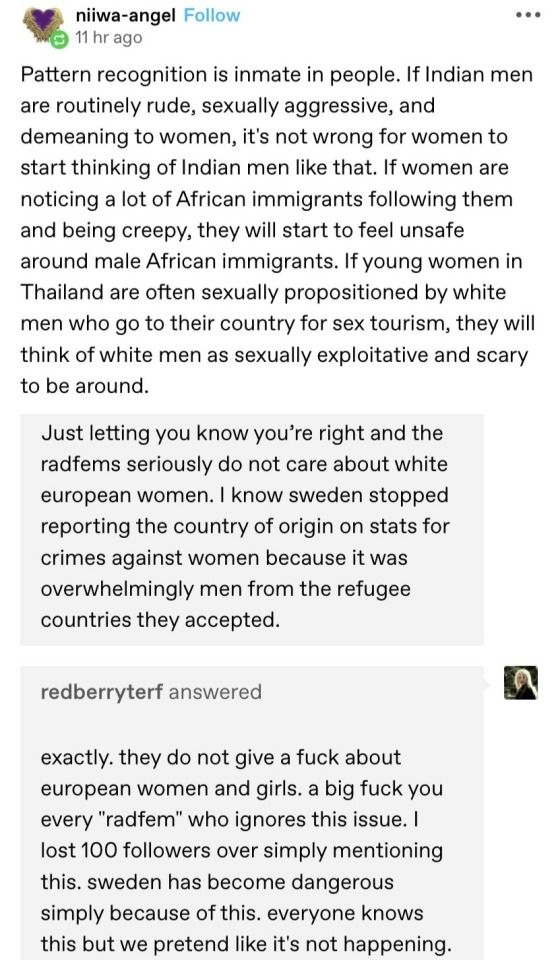
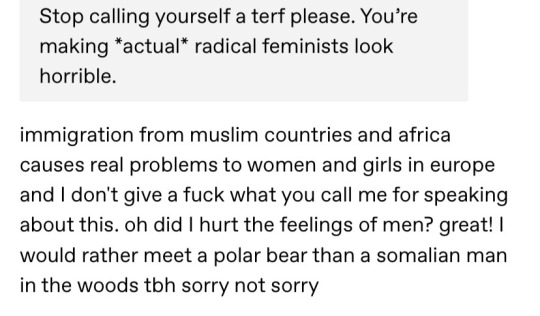
There is nothing i could say about this that would communicate more than just the posts themselves
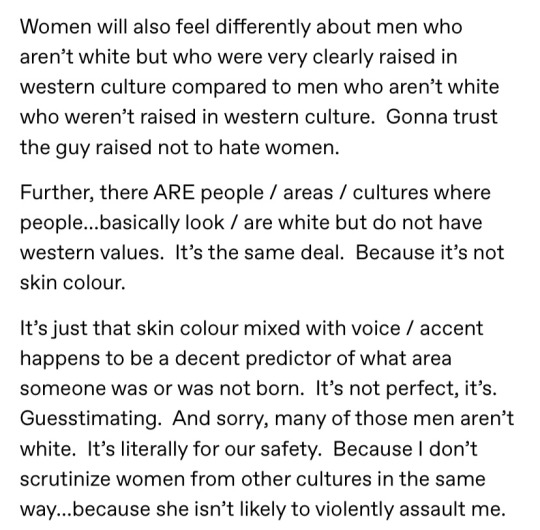
That's Racism. You Just Described Racism. It Does Not Stop Being Racism because you believe there are real differences between how violent different ethnicities are. That Is The Racism
Miscellaneous other rancid takes within a few reblog chain links of the above

this person had another post like "why are we funding ozempic when you can just lose weight by replacing all the fast food in your diet with vegetables? it's easy!"
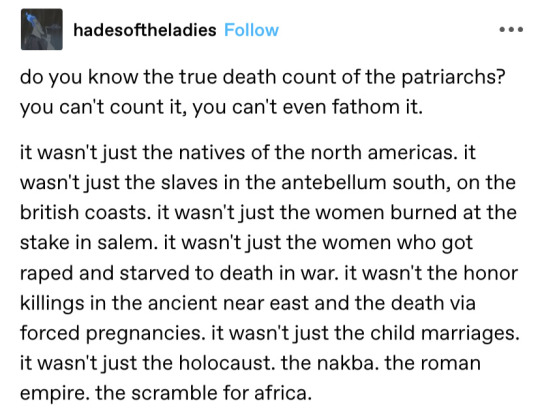
zero people were burned at the stake at salem.
...
okay but how do I even BEGIN to extract the infected ingrown toenail of stupid that this post nauseatingly embodies. Terfs have this whole genre of post that mourns every devastating historical evil as an atrocity "men" perpetrated, caused by "patriarchy/male violence."
Sure. Whatever. Slavery in Britain and the southeastern USA, (the only places slavery existed), the Holocaust, that was "male violence," caused by men, because men are violent and violence is male. Women are definitionally incapable of violence and have never ever ever abused power over others and the world is made of pudding.
Out of the 19 people executed at Salem, by hanging, 5 of them were men. This doesn't matter because facts don't matter, what matters is that the Salem witch trials are the example of violence prompted by alleged "witchcraft" that you can remember without googling it, and in the deeply symbolic mythology of your ass backwards brain, violence against alleged "witchcraft" is always ACTUALLY patriarchal retaliation against Women's Knowledge, which is always ACTUALLY an ancient genocide of women that transcends culture, which by the way is what you're experiencing when people are mean to you online.
Therefore the Salem witch trials, an event with fewer casualties than the Boston molasses flood, is similar in significance to the Holocaust.
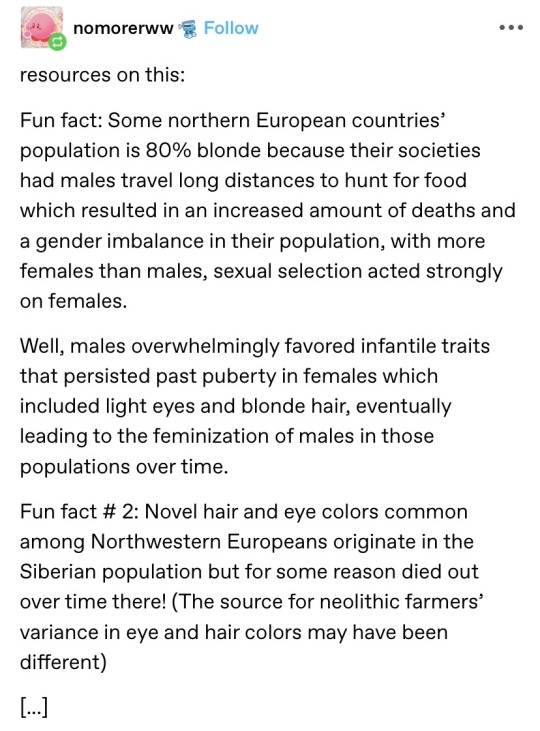
Wow. Such biological reality. Very scientific facts.
820 notes
·
View notes
Text
Occasionally JK Rowling says or does something so offensive to my sensibilities that I must speak. Sadly, today is one of those days.

This post, and the "male" she is referring to is a cis woman boxer from Algeria. There is an unconfirmed report that she might have an intersex condition in which one's chromosomes are XY. She may not even have this condition, but even if she does, it does not mean anything but that she has an unusual DNA quirk. We do not call Tom Cruise a woman for having an extra X chromosome, for example (nor would I expect Rowling to accept it if he decided to compete as a woman in the Olympics).

Now Rowling, upon being pointed out that she essentially pulled the twitter equivalent of Austin Powers punching that old lady because she "looks rather mannish", moves the goalpost. She claims, against evidence, that she an unfair advantage, going so far as to imply that simply by competing with a rare condition this woman has cheated.
This might seem bizarre coming from a self professed FEMINIST. It is the contention of anti trans "feminists" like Rowling that womanhood is being erased and destroyed by "trans ideology"; Yet here a cis woman achieves a olympic victory and they accuse her of being a man, of cheating. They erase her achievement, they erase her womanhood.
The subtext is racist and misogynistic - a strong Algerian woman with features that do not reflect Western beauty standards is being denied the very womanhood that TERFs claim to protect. She has lost to women before, she has no clear advantage... Yet by virtue of her looks and a possible rare genetic condition, she is now a "man" and a fraud.
This doesn't surprise me, and I suspect that anyone who has had to deal with TERFs will agree. But in case anyone is shocked here's my take:
TERFism has always been a reactionary movement. While it draws from second and third wave feminists and has an ideology on paper, any space with TERFs will tend to feature mad crusades accusing cis women of being trans on looks, attacks against sex workers that are harsher than those on the men who make that industry dangerous, few towards actual men, and a sense of outrage that trumps any real ideology.
It is feminism much like how "National Socialism" was socialist. And like the Nazis did with socialism, it uses the idea of feminism to legitimize attacks on perceived enemies while preserving the status quo. For TERFs that's traditional gender roles, which they have twisted into something that protects women rather than subjugates them. (This is not to say TERFs are Nazis, but it is a decent comparison because fascism is the ultimate reactionary ideology; full of symbolism and mythology yet devoid of any substance but machismo and hate.)
In a nuanced, good faith society, we might discuss trans women in sports using science to determine whether there are unfair advantages, and consult stakeholders and experts in sport and biology. We might study if chromosomes do impart an advantage, and weigh that against the other myriad genetic advantages like long reach or faster muscle gain to determine if there is any problem with current regulations. We might not do these things too, considering we have gone the entire history of sport without a single women's league collapsing from secret "male" invasion.
In Rowling's world, we first attack the winning woman as a "man in disguise" and rail against her without evidence. We have people replying "just look at HIM, he is clearly male". We have people writing violent revenge fantasies in which the Algerian woman gets beaten by a man or a gang of women to "teach her a lesson"... and JK does not once jump in to say any of it is inappropriate or hurtful to women who happen to have androgynous features, like some less fanatic people sharing the story have done.
When this is how their "ideology" reacts to an apparently "male looking" woman winning, we have to ask whether the liberation of women was ever the goal.
And the one thing that makes it all make sense, IMO, is that it's the lashing out that's the point. These people seem to enjoy calling a cis woman a man in much the same way they enjoy calling a trans woman a man. They enjoy the feeling of power as together they act cruel towards a woman who had the audacity to beat a white European. They seem to relish the ability to present themselves as feminists in one breath while brutally harrassing and demeaning women. Unlike ordinary bigots, they constantly bring up their crusade, as if they're growing dependent on the thrill. The cruelty, as they say, seems to be the point.
The danger of these ideologies is really becoming obvious ahead of the US election. Years of social media bubbles and astroturfing have made people like Rowling convinced that they are a silent majority, ironic for people who can't shut up.
Times like this I think are important reminders of where this can really lead. They may spin about being gender critical or concerned about women when the pressure is on; This is what these people do when they think they can get away with it.
This is the dark heart of their movement, beating loud enough to hear.
#anti jkr#unsolicited essay#jk rowling#trans inclusive radical feminism#pro trans#nonbinary#terfs hate women
587 notes
·
View notes
Text
A Basic Guide to Vedic Astrology
I think many of you are new to Vedic astrology, so I thought I'd give a little intro to some of the concepts, terminology etc
First and foremost, Vedic astrology dates back to 5000 BC - 10,000BC, which means it only takes into account Sun, Moon, Mercury, Venus, Mars, Jupiter, Saturn and the 2 nodes of the Moon, Rahu & Ketu along with your Ascendant. Outer planets like Uranus, Neptune, Pluto along with asteroids are NOT calculated as most of them were discovered only in the last 2-3 centuries.
A conjunction takes place when two planets are placed in the same nakshatra within 5 degrees of each other. Even if they are placed more than 5 degrees apart, so long as they are in the same nakshatra, they can to some extent be considered as conjunct (the effect will be less potent than an exact conjunction basically) BUT if you have Sun in Ashwini and Venus in Bharani, you DO NOT have Sun conjunct Venus in Aries, that is NOT how it works. Those two nakshatras have entirely different themes, mythologies, purposes, deities, planetary influences and lessons, how on earth can they be considered "conjunct"???
That said, wherever you have a conjunction in your chart will have a major influence on you. It is a very potent energy. Dont ask me if having Saturn conjunct Ketu in Ashwini makes you a Saturnian or a Ketuvian because that's not the point, its that those two planets have a specific relationship with each other in your context and to understand the functioning of one, you must look at the other (along with its placement, aspects etc etc)
There are 12 rashis, corresponding to zodiac signs and each rashi is divided into 2 or more lunar mansions called "nakshatras". If you've wondered why say Arieses all act so different, its because they're either UBPs or Revatis in their Vedic chart, contributing to vastly different personalities.
In Vedic astrology, we have the concept of 7 charakarakas all of which indicate a different purpose:
Atmakaraka aka the soul indicator. it is the planet at the highest degree and represents your soul/being. its your compass and points towards the calling of your soul
2. Amatyakaraka, it typically points to your career/profession and works alongside your atmakaraka. it is the planet at the second highest degree
3. Bhratrukaraka (planet at 3rd highest degree) points to relationships with siblings
4. Matrukaraka ( planet at fourth-highest degree in your chart) signifies your relationship with your mother or maternal figures. It represents the nurturing qualities within you and helps illuminate your connection to your mother or motherly figures in your life.
5. Putrakaraka (planet with the fifth-highest degree in your chart) reveals your approach to parenting and your potential for creativity. It provides insights into your connection with your children and your capacity for artistic expression.
6. Gnatikaraka (the planet with the sixth-highest degree in your chart) indicates obstacles and adversaries in your life. It reflects your ability to overcome challenges and confrontations, making it a valuable guide for navigating life’s hurdles.
7. Darakaraka (the planet at the lowest degree) it is associated with your spouse and romantic relationships. It uncovers the qualities you seek in a partner and offers insights into how you relate to your significant other. Understanding the Darakaraka can provide clarity on your love life and partnerships.
HOW TO STUDY NAKSHATRAS:
Read about the mythology behind your nakshatras. This helps shed light on its nature.
Look at your nakshatra's yoni consort. Read about what the yoni animal symbolically represents
Similarly, read about your nakshatra's deity, ruling planet, other naks under the same planetary influence etc
There are 4 purusharthas (aka motivations) in vedic astrology according to which nakshatras are classified. understanding the different classifications behind each nak helps us understand its nature better

similarly naks can also be classified by their ganas which describe the nature of these naks:
Deva = godly, Manushya = humane, Rakshasa = demonic
if you have a rakshasa gana nak, it does not mean you're a demon. it just points towards traits like selfishness, lack of generosity etc AND the person you are is sum of your whole chart, not just the gana of one nak, so don't beat yourself up

Naks are also classified on the basis of their qualities of which there are 7
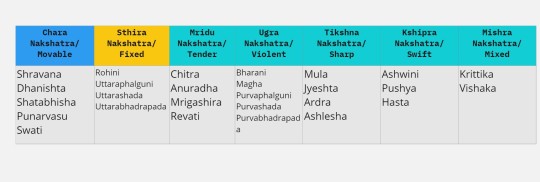
they can also be classified on the basis of caste:

(all tables, pyramid etc by me so any mistake is mine oopsies)
4. Chart Ruler
The ruling planet of your ascendant sign is your lagna lord. If you're Mrigashira Rising, then your lagna lord is Mercury/Venus (based on whether your nak falls into the Taurus portion or the Gemini portion).
5. Navamsa or D9 chart
Look at your D9 after you've studied your D1 otherwise it'll feel like too much info you don't fully understand. Navamsa is consulted along with your D1/Birth chart. you can think of it as D1 promises certain things and D9 is if/how those things materialise. its like part 1 and part 2 of a story
I can't think of anything else that should be covered🤡but if you have doubts you can ask!!
I hope this was helpful!!
#astrology notes#astrology observations#sidereal astrology#vedic astro notes#nakshatras#astrology#vedic astrology#astro notes#astro observations#astroblr#jyotish
692 notes
·
View notes
Text
One of the things I hear a lot from Gentile witches and neo-pagans who want to work with Lilith or claim to work with Lilith, is that she is actually a Mesopotamian goddess, usually either Ishtar/Inanna or Erishkigal, and that it was the Jews, with their horrible patriarchy juice, who slandered her and cast her down, and so the Jews do not deserve to say what happens to her and it isn't antisemitism to work with her, or to completely ignore what the Jews say about what she is in a Jewish context.
Lilith is not Ishtar or Erishkigal. However, there is a Mesopotamian figure that is pretty stinking analogous to Lilith, and is probably her folkloric ancestor, by which I mean the idea of Lilith probably comes from this Mesopotamian figure. In fact, Lilith almost certainly is either a Jewish version of this figure, or, they are both descended from the same Near Eastern and Mediterranean basin folkloric figure. That figure is Lamashtu.
Lamashtu is, much like Lilith, the supernatural embodiment of maternal and infant mortality, a figure of power and terror, who functions as a way to embody and cope with the profound dangers that are pregnancy, childbirth, and infancy without effective medical care. the Mesopotamians never worshiped Lamashtu, but they did seek to appease her, including making symbolic gifts to her, to keep her from visiting them, and killing them or their children.
An interesting side note is that there is also a Mesopotamian figure who specifically opposes Lamashtu and functions as the protector of pregnant women and infants, and that figure is Pazuzu, a wind spirit, who ruled over other wind spirits, including ones called the Iilu in the Akkadian language. Akkadian is a Semitic language, related to Hebrew, and this word is probably a cognate of Lilith, but the Iilu probably have no relationship to the figure of Lilith except her name. You might know Pazuzu as the demon featured in the movie, The Exorcist, and ironic fate for a mythological protector of women and children.
Anyway, if you'll remember, I implied above that the Lamashtu/Lilith figure, was present in various guises throughout the Mediterranean basin and the Near East, so there are of course figures analogous to both of them throughout the region, such as Lamia of Greece, and the Strix of Rome.
So if you really really want to work with a figure who functions as the supernatural embodiment of maternal and infant mortality, Lamashtu, Lamia, or the strix would all be excellent options that don't come from an extant closed religious practice. All the baby killing, none of the antisemitism and cultural appropriation.
While all three figures are almost certainly descended from the same folkloric root, they're all subtly different, because as stories and characters travel, they change. as such, they all have particular good points about them as figures of veneration.
Lanashtu is the OG bad bitch, who commanded fear, respect, and offerings, like a mythological mafiosa, collecting protection money.
Lamia has attached to her the story that she was one of Zeus's dubiously willing lovers, who was screwed over first by Zeus, the embodiment of patriarchical rule, then by a jealous Hera, the embodiment of patriarchal marriage, so if what attracted you to Lilith was the story from the Alphabet of Ben Sira, about a victim of the patriarchy getting her own back through violent vengeance, Lamia might be the girl for you. With her however, the emphasis is less on her murder of children, then on her seducing and eating men, though she does also get strongly associated with killing children, especially boys.
And the strix is particularly interesting, because the word comes down to us in the modern Italian word for witch, striga. Indeed, one of the theories as to where the witch figure came from in Early Medieval, and then Early Modern Christianity, was as the strix demon made human. This might explain the close association between Early Modern Witchcraft and infant mortality, including Italian stories of witches causing infants to die seemingly natural deaths, so that they could dig them up and eat them after their funerals, something that ties these human supposed witches very closely to demonic folkloric antecedents. If you are looking for a figure of unfairly maligned female power, the strix and her close association with later human witches, might be the one for you.
All three of these figures, much like Lilith herself, are reflections, both of the power women wielded even within patriarchal societies, over the process of pregnancy, birth, and childrearing, and also the powers of death and loss that everyone was subject to. There is something powerful, transgressive, and even healthy in acknowledging the fears and dangers presented by this death and loss,and for some people, that might take the form in venerating the underlying powers. If this is something that would be spiritually meaning for you, and you wish to work with such a figure, and you are not Jewish, please respect the fact that Lilith is part of a closed religious practice, and remember that Lilith has sisters, in other parts of the Mediterranean basin and the Near East, who are not from extant closed cultures, and who might serve your needs better anyway.
721 notes
·
View notes
Note
You seem to be the Knower of life series lore so I am sending this question to you.
What is Cleo’s symbol in the victors rhyme?
I’m pretty sure that it’s been more it less decided that Grian is the sun, Scott is the stars, Pearl is the moon, Martyn is mars (or a comet, it varies), and Scar is the earth, but what about Cleo? I’ve seen her called the fool but I have no clue if that’s actually her title or if she even has one.
Thank you, and have a nice day!
Pluto!
That's the most popular symbolism I've seen thrown around, for many reasons.
In Greek mythology Pluto corresponding god is Hades, god of the dead and ruler of the underworld, very fitting for Cleo's zombie persona
Pluto discussion on whether it should be considered a planet or not, matches the discussion if Real Life should be considered "official"
It also represents changes and transformation, Real Life gimmick was very different than everything seen before
People also like "The Fool" for her card symbolism because Real Life was an April fools special episode
As a last note, you can have your own headcanons and you don't need to follow what the majority of people thinks, at the end these are just headcanons we come with to have fun!
91 notes
·
View notes
Text
Beast-Yeast Episode 6 Predictions
Felt like popping in and listing off my ideas/predictions for the next half of the update before going back to work:
Burning Spice will not take the Soul Jam back right away. Against his better judgment, he will simply toss Golden Cheese down the cliff and lay back again. Both just to watch her suffer/squirm, and because he really is disappointed in their fight and wants more out of her, so he's being nice and giving her one more shot to get up and prove herself to him
Golden Cheese will be taken in by the kulfi monkeys, who will be extremely grateful for her essentially sacrificing herself to save one of their own (especially after they sort of threw her out of their village earlier). They, or at least that elder, will come to see that she's the god mentioned in their prophecy and will do what they can to nurse her back to health so she can get back in the ring and defeat Burning Spice once and for all
Smoked Cheese will reach the logical conclusion regarding the spices in the air being the ashes of fallen Wild Spices, and use them to create a whole army of zombie soldiers to hold the Spice Swarm at bay while Golden Cheese VS Burning Spice 2: Electric Boogaloo happens
Golden Cheese's revelation will likely be inspired by her reflecting on saving that kulfi monkey kid. Perhaps by touching on her previous thought "they're just like my treasures", on reuniting with Smoked Cheese, and on the people she's met on her journey in Beast-Yeast. She may think back to Burning Spice telling her "you will crumble and become dust, like all those trinkets you held dear" and realize that no, she shall not, for she still has trinkets to protect - her cheesebirds, Smoked Cheese, all of her citizens still waiting to be revived back home, and now, these spices she's come to care for so quickly and accepted as her own. She has endured great suffering, but she cannot and will not stand by and allow it to be inflicted on others while she's actually there to stop it
Golden Cheese's awakened form will take after Ra, the Egyptian god of the sun and leader of the Egyptian pantheon
Specific additions to above point: Awakened form will either A) look like the bennu bird (or the bennu heron), mythical animal/being in Egyptian mythology considered to be the soul of Ra himself, who rises from the ashes each morning and is seen as a symbol of creation and rebirth, B) be accessorized by all kinds of priceless jewels and minerals, as a more frank/simple nod to her love of wealth and opulence, or C) have technological augmentations of some sort as a nod to the digital version of the Golden Cheese Kingdom. (It could also be D) all of the above, but I doubt it)
Golden Cheese will win (duh), but Burning Spice will be less upset than anyone thinks. He will be glad that he finally managed to face the formidable opponent he'd always known Golden Cheese to be and was waiting to fight in the first place. Of course he'll be angry that he's been denied the return of the missing half of the Soul Jam, but... damn it, he had a blast and he can't be mad about that. But he'll be back eventually, of course... for the Soul Jam, but also - perhaps even more than that - to fight Golden Cheese again, because now he's got someone to keep him from being bored forever
The Wild Spices will be swayed to Golden Cheese's side and perhaps even want to fully become her subjects, as they respect strength/power and she just kicked their boss's ass pretty soundly so... (Not sure about Nutmeg Tiger, she'll probably be stubborn and stay under Burning Spice but secretly have her faith/loyalty shaken, if not completely shattered) Further proof of this occurring is the loading screen quote "The Wild Spices worship the Great Destroyer out of fear. But what if... they desire something more...?" Golden Cheese is that "something more". They'll see it. They'll turn away from Burning Spice and seek her leadership instead.
I'm sure I'm not the only one who's thought of these, but I wanted to jot them down anyway. Let's see how it goes.
You all have to come back here and like/reblog if any of these turn out to be correct.
#cookie run#cookie run kingdom#burning spice cookie#golden cheese cookie#smoked cheese cookie#nutmeg tiger cookie#burning spice crk#golden cheese crk
135 notes
·
View notes
Text
So as some of you may know, I am... let's say an armchair-level amateur scholar of classical studies. @qqueenofhades can tell you how often she has to talk me down off the ledge of enrolling in an MFA program.
Like some of you, I was an insufferable twelve-year-old when Disney's Hercules came out, and all of my critiques of that film were down to "it doesn't do the mythology right".
Well, I've reached the point where I don't care about that shit anymore. Go nuts. Have fun with it. There are, however, some... History Tik-tok tumblr Bad Takes about Greek mythology that I have very little patience for. #Girlboss Persephone, for instance, or basically anything that insists on treating the Greek gods like people, whose behavior can be judged as more or less Problematic, rather than... symbols, archetypes, divinities.
I am happy to say that Kaos, while it obviously plays fast and loose with basically every element, captures the vibes of Olympus. The feels. Jeff Goldblum's intense, eccentric and fucking terrifying performance as Zeus, the flawless Janet McTeer as Hera, Cliff Curtis as Middle-Aged Jaded Slutty Maori Fuckboy Poseidon, David Thewlis' exhausted, depressive turn as Hades... all of it is GOLD. It has instantly become one of my new favorite adaptations. Like all good adaptations, it captures the flavor, the vibes, the FEEL of the original works.
Here's some of my other faves!
Gods Behaving Badly, by Marie Phillips - a goofy, fun little romp about the past-it and aging Gods of Olympus living together in a shitty house in London. A comedy, but it very accurately captures the essence of the vain, fickle, and usually stupid Greek Gods.
Circe, by Madeline Miller - I mean, I hope to God everyone has already read this one, Jesus Christ. Told from the first-person perspective of the Goddess-witch Circe, this book is an amazing re-imagining of one of the most maligned and studied characters in the Odyssey.
Hades 1 & 2. by Supergiant Games - I could write several thousand words about how much I love these games, which both revolve around the challenges of an immortal family that you literally cannot get away from -- and the way cycles of violence perpetuate themselves, even if the people involved CAN'T DIE. The depths of the scholarship on display there are frankly staggering, and they go DEEP into the esoterica -- Zagreus teasing Orpheus that he and Dionysus are the same person (which they almost certainly are, don't get me started on Orphism) springs to mind. Hell, the second game's protagonist is literally Melinoe. Also, Scylla is a boss fight and is the lead singer of a bratty girl group and sings a diss track about how your hair is a disaster. What's not to love.
... I do wish they hadn't made Kronos the God of Time. That shit drives me nuts. The words are cognate but not--he was an agricultural--ANYWAY.
Kaos is intense as hell, but it's fucking GREAT. And literally every frame is filled with Gays and people with different bodies and body types and various flavors of gender fuckery. It's great. Watch it.
84 notes
·
View notes
Text
Alice clues
If you didn't think this show has put an amazing amount of detail into their storytelling methods, may I offer you exhibit A.
This is a scene from episode 2 where we first meet Alice - doing her security gig at Hot Topic. Knowing what we know now... have a look!

Besides the obvious red aesthetic, there are so many little details packed into this one shot! First of all... Have you spotted the ouija planchette yet? (in the upper right corner)
They are telling us her story here!
There are also phases of the moon right by her knee (might be too tiny to see here). The shirt on the left has red skulls all over it and there is a poster of a red skull made out of cobweb - suggestions of death (especially as Aubrey Plaza's end credits have spider as a background). It looks like there is red firey dragon poster behind her too, maybe referring to her being the protection witch.
The image of a man behind her reminds me of Mac Fleetwood, but don't quote me on that. Does anyone recognise it? At first I thought it looked a bit like Jesus (resurrection?) but it's not quite the same.
There is also a sign that says "Time to cash in"... Any ideas of what this could mean other than another death prediction?
Things that make a bit less sense is the shirt to the right - it has mushrooms and fairies on them (and the fairy lights?). The only mention of fairies in the show so far has been when Jen questioned Sharon about the poison effects. "Do you hear the sound of fairies crying?" but I have no idea what that could mean.
There are soooo many different stories and interpretations as to what fairies could symbolise here (e.g. games, growth, deceit, illusions). But I wonder if this is maybe a reference to Fairy realm, or Otherworld, thought to be a parallel dimension ruled by Queen of the Fairies. Historically, there have been women accused of being witches for conversing with the fairies.
I say this because it could work with this next element. There is an image of a raven surrounded by red flowers (towards middle left). You can't quite see it in full here, but when Alice exits the shop, they show it to you again.

Ravens can again symbolise different things. For some they are thought to be harbingers of death. For others they are symbols of transformation. In general though, they are thought to bridge the "chasm between light and shadow" and e.g. in Norse mythology they were messengers between the human world and the divine.
This is even more interesting, because Ali Ahn's end credits have a background of a pentacle with candles around them. AND in a very brief moment, as the pentacle moves into the screen, we can also see the writing "Can you talk to the Dead?"

Now, I know this is a stretch, and more likely than not this is all just a simple reference to the fact that Alice dies in the episode where they try to talk to the dead.
But what if there is a bit more to it and Alice will act as some sort of a messenger for the witches? We know we will see her again according to the promos, but it looks like it will simply be a scene where Rio "wakes her up" to take her body? What will happen to her soul though? (seeing that Rio seems more interested in the bodies) So what if there is more to it?
Even Jac Schaeffer in her latest ep.5 interview, when she confirmed that Alice really is dead, she followed it up with these exact words:
"What I will say is that, it’s not the end of the conversation, is what I would say."
Oh and bonus photo - there even is a red pentacle drawn on the floor of the Hot Topic shop - we see it as Alice gets up to trip Teen when he runs.

#agatha all along#agatha all along spoilers#agatha harkness#kathryn hahn#aubrey plaza#rio vidal#alice wu gulliver#ali ahn
55 notes
·
View notes
Text
Bird Symbolism in Revolutionary Girl Utena
There is quite a large amount of bird and bird-related imagery, symbolism, allegories and metaphors in Revolutionary Girl Utena, and i think all of them are very interesting. Here is a ~2000 word essay about the topic.
The Birdcage Garden: Anthy and Ohtori Academy

This is perhaps the most obvious of the bird symbols in Utena. It is literally Anthy's cage. It is where she, as the Rose Bride, is supposed to spend her time watering the flowers. Touga talks about never letting her out of it once he wins her, and calls her a "lovely little bird." And doesn't that just sum up what so many people's idealized version of her is like? A pretty thing to be admired, only in captivity.
I think the birdcage can also be seen as a sort of microcosm of Ohtori Academy as a whole. Akio does call the school "a garden where people will never become adults," after all, and Anthy is not the only person trapped there, nor is she the only character associated with birds.
According to this analysis, "Ohtori" as a word can mean "big bird" in japanese, and is also a Japanese term for the Fenghuang bird in Chinese mythology, said to be "beautiful, immortal and rules over all birds." Sounds a lot like a certain someone in charge of this place, doesn't it? Which would make every person in Ohtori a bird, symbolically speaking, trapped in the cage that is the academy and ruled by Akio (who, despite being the biggest, and the one with the most control, is also a caged bird.)

Additionally, the statue on the gate to the dueling arena is in the shape of a bird, before it transforms into a rose when opened. I am not sure exactly what this means, but I assume it is in some way symbolic of Akio, Anthy and Ohtori.
The Bird and the Window: Shiori and Juri

The bird that flies into the window during Shiori and Juri's conversation in episode 17 is a Java Sparrow. Despite its name, it is a part of the Estrildid Finch family, but I think the symbolism for sparrows fits the context more, as they can represent love, devotion and compainionship, all of which are very relevant for Juri and Shiori.
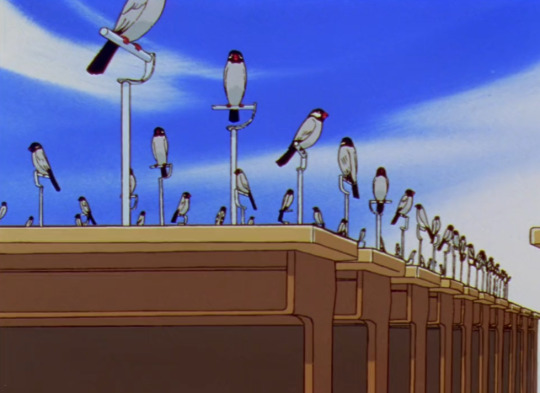
The bird is also the symbolic item for Shiori's black rose duel, which means we should associate the bird mainly with her. What, exactly, is the window, then? I think it is symbolic of Shiori's feelings for Juri, Juri's feelings for Shiori, or most likely both. The bird hits the window directly after Juri says "Is that all you have to say to me?" and turns to leave. The bird hits something it could not see in its flight, just as Shiori hits against something that hurts her, even if she doesn't understand it, in her conversation with Juri. The bird is shown to be lying still, presumably dead, after Juri reveals that she was never in love with the boy Shiori "stole" from her.
The bird is shown again after Juri throws her locket in the lake, and before Shiori finds it in her dorm. I've heard it discussed that this implies the bird retrieved the locket (probably through Anthy-as-Mamiya), and if the bird is symbolic of Shiori and the locket is symbolic of Juri's feelings for her, it would mean Shiori is the one to bring them back after Juri tries to rid herself of them. This makes sense.
The Bird Nest: Kozue and Miki
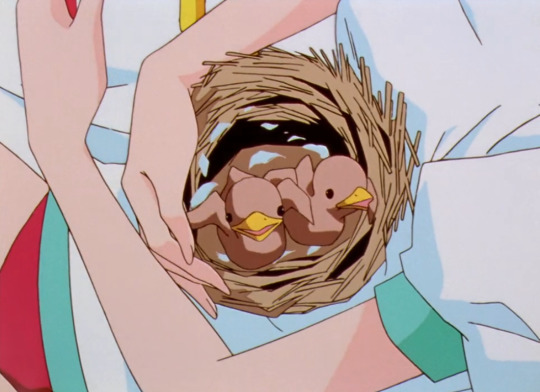
The bird nest that Kozue rescues from the tree that is going to be cut down is symbolic of her and Miki. Or, at least they are symbolic of how Kozue views the two of them. The comparison is pretty straightforward; Kozue projects her and Miki's feelings of abandonment onto these baby chicks, who have been left behind by their parents, just like the two of them were when their parents divorced. I think she projects her protectiveness over her brother moreso than her own feelings about the whole thing, as Kozue likes to think of herself as very independent ("a wild animal") and very unaffected by it all. As seen by her attempt to save the birds in the first place, she is very willing to put herself at risk, and is less concerned with her own feelings/safety.
Now, I don't want to get too much into speculation, but I have to wonder if there was more going on in the Kaoru family than just the divorce and the too-high expectations for the "twin prodigies." Miki's uncharacteristic cynicism in saying "adults who tell you something is for your own good can never be trusted," as well as Kozue's total disregard for authority and her tendency to use her sexuality as a tool both concern me. Although Miki and Kozue's parents are not explicitly shown to be abusive, I do not think it is a stretch to say that there is a possibility that they were. It explains some of Kozue's behaviour in regards to Miki as well. It's not just posesiveness but protectiveness. She has needed to protect him before, and she feels she needs to protect him still (pushing the predatory teacher down the stairs, saving the birds she sees his innocence in.)
Interestingly enough, Anthy interacts with these chicks as well. She advices Miki on how to feed and take care of them. Utena even comments on how unusually straight forward she's being about the whole thing. This might just be another instance of characterizing Anthy as a person who is fond of animals, and that is certainly part of it, but i think there is more to it as well. If these baby birds are symbolic of (Miki and Kozue's, but also a general) feeling of abandonment by parents/adults, as well as their potential abuse, what does that mean for Anthy not only knowing how to take care of them, but being eager to talk about it? Could it perhaps be that she, like Kozue, sees herself in them? Like Kozue, Anthy herself is symbolically a bird, but a caged one in contrast to Kozue's claims of being a wild animal. Could it be that Anthy has had to become an expert in taking care of those (herself) that have been abandoned or failed or abused by the adults in their lives? Rememeber that this is the same episode where she says that Akio is more like a father to her than a brother. A parallel is indirectly being drawn between him and the Kaoru parents.
If Miki and Kozue's parents were abusive, this might be a rare moment of Anthy empathising with other victims, telling them through metaphor how to take care of themselves. Although, it doesn't keep her from continuing to manipulate them, as she goes on to say her line about returning the chicks to their mother, which is what sets Kozue off. Anthy also says that she's never actually raised chicks before. Maybe she's not very good at taking care of them (herself) after all.
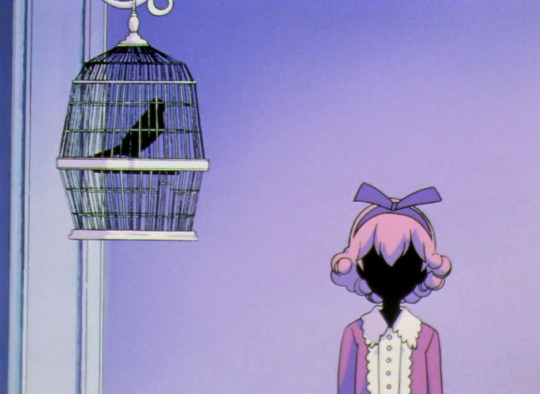
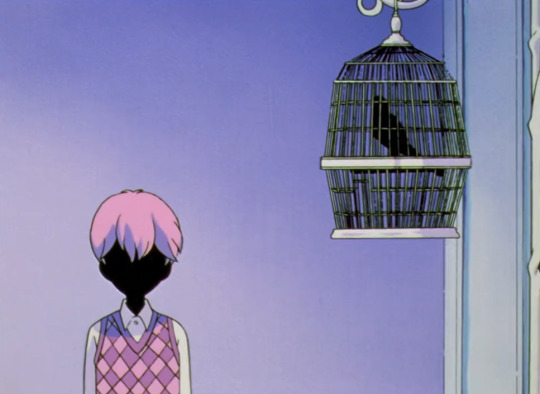
There's also what looks like two caged parakeets in Miki's flashback of their childhood. I assume this has similar meaning to Anthy's birdcage, as a feeling of being trapped, in this case by their parents' expectations for them. Kozue used to be a caged bird, but now claims to be a wild one, despite still being inside the birdcage that is Ohtori.
Brood Parasitism: Nanami and Touga (and Utena)
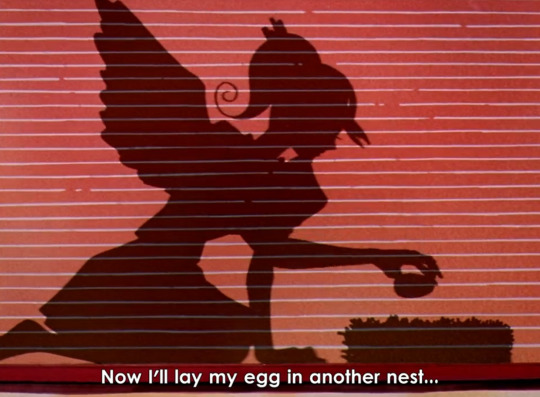
The Kaoru's are not the only sibling pair in Utena to be compared to birds. In Episode 31, Her Tragedy, a pretty unique shadow play is put on in the Chairman's Tower about a cuckoo leaving its egg in another bird's nest, a phenomenon known as brood parasitism. It also references the fairy tale The Ugly Duckling by Hans Christian Andersen. Perhaps the most interesting part of this play is that it's done in the style of the ones in the black rose arc, with C-Ko playing all the roles, the return of the monkey-catching robot, and Utena's fourth-wall breaking commentary at the end. I won't get into what this means, as it doesn't have anything to do with the bird metaphor, but maybe in another post.
This shadow play is about how Nanami and Touga were adopted, and specifically about Nanami's feelings on the matter. Of course adopted children are not parasites, but it makes sense for Nanami to think along those lines, considering her fear of being compared to animals or aliens, and of being ostracized by the society she lives in. Nanami doesn't actually know that she is adopted, only that Touga is, which muddies that interpretation a little. Perhaps it is about Nanami blaming Touga's birth parents for "leaving him in another nest"? Something about her resentment of Touga at this point in time, thinking of him as a parasite in their family? Or simply her fear of what not being his blood-relative means.
I'm more confident about the Ugly Duckling reference, and it being symbolic of Nanami's worry of not fitting in among her peers. Nanami mainly copes with this by thinking that the reason she doesn't fit in, is because she is actually better than everybody else, because she's related to Touga (being a beautiful swan among the common ducks.) The play ends with the cuckoo insisting that it will become a swan one day, when really it can't. It will never be a duck that fits in, either. It will always just be what it is, a parasite (a space-alien. A girl who lays eggs.) This reflects Nanami's despair at the idea that she's "just another fly in the swarm" after her duel in the next episode.
And like all the shadow plays this one can be interpreted as being about Utena as well. She is an orphan who is now being raised in Akio and Anthy's "nest". Although she wasn't placed there by anyone but Akio himself, so it's more about her insecurities about feeling like an outsider in their family. And like the Ugly Duckling/cuckoo, she is also out of place among the rest of the students, and dreams of growing up to be something she can't actually become, in this case a prince. (credits to this analysis on the shadow plays for helping me piece together my thoughts on that. Always cite your sources!)
Cuckoos can also be symbolic of one-sided love, and is the origin of the word cuckoldry. Make of that what you will.

I should mention that Nanami also lays an egg of her own a few episodes prior. ...Or does she?
Her nightmare sequences show her fears of being compared to a chicken, a turtle, a frog, and of course, a space alien, but it is quite obviously a bird egg. And since we are later shown that Anthy has a chicken named Nanami, much like the cow with the same name, it can be assumed that the egg comes from there, and that Anthy brought it to Nanami's bed, perhaps via Chu-Chu. Could this relate to the brood parasitism of the cuckoo in some way? Is this not one bird (Anthy) laying its egg in another bird's (Nanami's) nest (bed) and getting them to raise it? is this what Anthy means when she tells Miki she has never personally raised chicks? Are all of these metaphors connected??? There's also the fan-theory that Nanami's egg hatched a reincarnated Chu-Chu, and in that case would he be the baby cuckoo while Anthy is the mother and Nanami is the duck? I'll be honest I'm not really sure what to make of it at this point. Draw whatever conclusion you want!
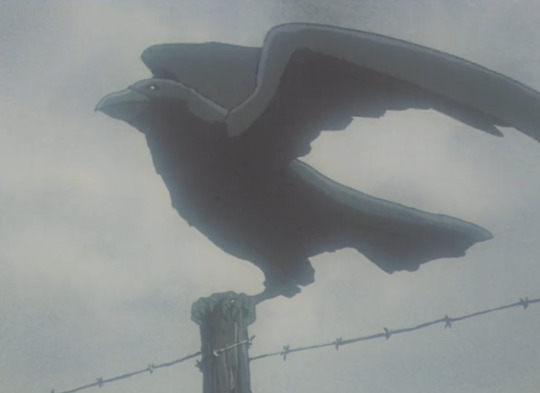
Last and probably least interesting is the third of Nanami associated bird imagery: the crow in episode 10. Crows can be symbolic of death, and it feels safe to say that this one is just here to set the mood of the scene, and as visual confirmation that the kitten did indeed die. Not too much to say there.
The Chicken and the Egg: The Student Council
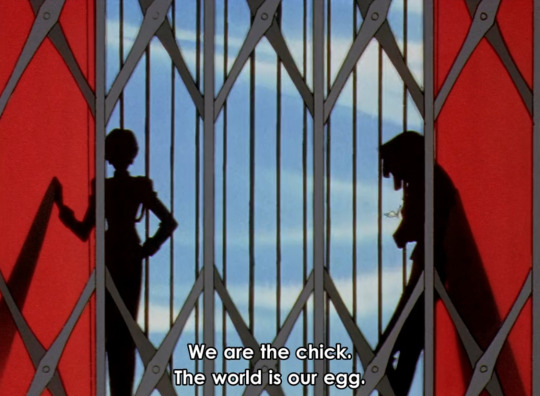
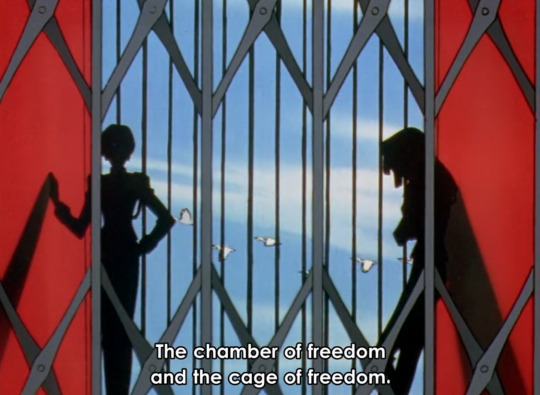
I'd be remiss if i didn't mention the student council's chicken and egg speech in this post as well, even if it has been analyzed to hell and back by hundreds of people before me. It is a reference to Hermann Hesse's book Demian. It is about breaking out of childhood and into adulthood. It is about escaping Ohtori, which is both the egg and the cage (and interestingly enough, during the speech birds can be seen flying by outside the cage of the elevator.) In Nanami's version of the egg speech she mentions "the cage of freedom" and how it cares for the chick. This something that ideally should be true for schools. A place that limits children, but in a way that prepares them for the adult world. Of course, Ohtori as a system has no interest in this, as it is a cage in its most literal sense: a place to keep people trapped. Trapped in their harmful behaviours, in their lack of growth, in their idealized memories of the past, and most of all, in childhood.
And with that, we have come full circle back to Anthy's birdcage as a symbol for all of Ohtori. Thanks for reading :)
#it's done! my first proper analysis-essay since my very first post on this account!!#i know it's long but i put a lot of work into this and i'd really appreciate if you read it ^_^#although i'm not entirely satisfied with the juri/shiori segment. if anyone has anything to add i'd love that#revolutionary girl utena#analysis#anthy#akio#shiori#juri#kozue#miki#nanami#touga#utena#m#animal motif#kaoru siblings#kiryuu siblings
307 notes
·
View notes
Note
If you don't mind me asking, what makes you interpret Angeal as anything other than a straight man? He's the least gay character I've ever seen and he doesn't act gay either.
I'm going to assume this isn't sent in bad faith but this is pretty on point with the definition of stereotyping. I mean if you’re defining being gay by how someone looks or acts that is your first problem. Angeal has very outwardly masculine actions and appearance, I’m not really a fan of the insinuation that masculine men don’t “look” gay enough. Angeal isn’t even a hyper masculine or toxic masculine character, he is almost always described in a way that is seen as nurturing or caring. His own fan club compared his hobby of cooking to that of a wife. Things like gardening are often seen as more a “feminine hobby.” This isn’t to say Angeal breaks insane boundaries but Angeal isn’t this rigid masculine character in the first place. Besides my personal headcanons, Angeal and Genesis' stories take quite a bit from The Fall of Mankind (and religious and mythological symbolism in general but I'm going to try to stay on track). They purposely made two male characters represent Adam and Eve, and this isn't the first time they have done something like this in a final fantasy game. For example: while they are more developed than Genesis and Angeal, characters like Fang and Vanille are based on the Nordic myth of Ragnarok. There is a lot of information that couldn't be included in the final game of Crisis Core but is still intended canon, I'm going to be using a lot of that as a reference point. The full explanation is pretty extensive and I'm also not an expert on The Book of Genesis. I tried my best to do research for this, but it is possible I am still missing things and that this can still be expanded upon.
I'm going to start off by giving a deeper explanation on how Angeal represents Adam and how Genesis represents Eve. Genesis already has a very strong connection to The Book of Genesis because of his name. Rhapsodos comes from rhapsody, his full name is literally "genesis reciter". Genesis and Angeal were the first two attempts at an artificial “cetra” created by Shina representative of Adam and Eve being the first humans created by god. (While there is some debate if the first woman is Lilith, she is often been seen as a demoness.) The kanji for Shinra already is a direct reference to god, and is symbolism for how they like to play god themselves. The image below has a great explanation that is much better than what I can do, but to keep it short 神 (shin) literally means god or divine and 羅 (ra) is derived from 網羅 (mōra) which means "encompassing".

The fruit of knowledge is typically portrayed as an apple, which connects with banora whites. It represents temptation, Genesis offers the apple to others when talking about truth and revelation. Instances like in Nibelheim, Genesis offers the fruit to Sephiroth after telling him the truth of his origins. Sephiroth rejecting the fruit is a sign of him rejecting the truth, and we see he continues to go along with a story he is happier with. Sephiroth decides to believe misinformation that is less painful, the rejection of knowledge is indication he is not Adam or Eve.
Banora is heavily connected to the flow of the lifestream, which is what makes Banora whites grow any time of year. The lifestream is said to contain knowledge of the planet and its people, that being what powers the fruit further reinforces the idea that they represent the fruit of knowledge. Banora being the source for what is essentially miracle fruits powered by the planet, it is clear Banora is meant to be Eden.

Minerva is said to be sleeping in the caves of Banora, she represents the will of the lifestream. Though Minerva is connected more to Roman Myth and Sophia from Gnostic belief, I would still say she emphasizes the holiness of Banora's land.

Angeal has a story about not stealing to reflect Adam trusting god and not taking from the garden. God's words to Adam were "You are free to eat from any tree in the garden; but you must not eat from the Tree of the Knowledge of Good and Evil, for when you eat from it, you will certainly die." (Genesis 2:17) Angeal stole from other trees besides the big one that had the most delicious fruit. While it can be argued Angeal didn't steal from Genesis in general, Angeal's story focuses solely on the biggest tree with the most tempting fruit, that tree represents the tree of good and evil. At the end of the game, Zack eats an apple under this same tree with Genesis, protagonist and antagonist sharing from the same tree. Shortly after eating the apple Zack learns the truth about how long it's been and leaves to meet his fate.
Hollander approached Genesis with the truth of his origins, convincing Genesis to help him with his plans in exchange for a cure that Hollander never had. Eve was afraid of eating the fruit and dying because of what God told her, but the serpent convinced her she would live. “You will not surely die. For God knows that when you eat of it your eyes will be opened, and you will be like God, knowing good and evil.” (Genesis 3:4-5). Both being deceived, they were convinced that they would live if they defied God, and become the catalysts for knowing the truth. Eve did not want to be alone in her defiance so she looked to Adam, much like how Genesis approaches Angeal to persuade him to take revenge against Shinra.


Besides Eve being referred to as Adam's wife, Adam also placed his trust in Eve above god. He decides to listen to her and trust her despite his creator telling him he will die. Angeal places his trust in Genesis above Shinra when he decides to defect, believing he can rationalize with him despite this being high treason.
This has happened before already, Angeal placed his trust in Genesis above Gillian and defies his mother to join Shinra. Gillian didn't want her family to be connected to Shinra and despite how highly Angeal respects his mother he still defied her wishes for the sake of following a dream with Genesis.

This leads into the next part, less about how they parallel The Book of Genesis and more about how they parallel other characters in the narrative. This makes me a little nervous to talk about so I’m going to put a small disclaimer that I am not arguing for any canonicity of ships because I think it is a waste of time. However, I think discussing characters' feelings that push their motivations is important.
In the narrative, Angeal also greatly parallels Cloud, I feel like this isn’t something that is talked about enough in general. They share a great deal of small parallels like both enjoying landscape photography, being associated with wolves, and elementally representing lightning. Besides surface level things, both Angeal and Cloud have a guilt complex and feel responsible for the people around them. The main parallel that’s important to this conversation is their childhood friend from the same countryside town.
Cloud was inspired by Sephiroth and his desire to protect people he loved like his childhood friend, Tifa, to join soldier. This is similar to Angeal joining to be with Genesis; their childhood friends are motivators for both of them.

This is something that’s pointed out in DFFOO as well, Angeal hears about Tifa and immediately draws the connection.
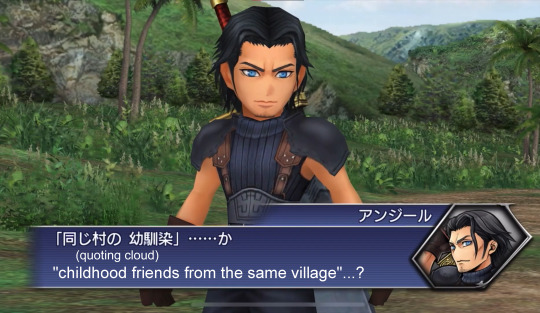
Both Cloud and Angeal feel responsible for protecting and looking after their loved ones, Angeal is seen as a caretaker type for this reason. Both Cloud and Angeal want to help fulfill the dream of their childhood friend, Tifa's was being saved by a hero and Genesis' being to share an apple with his hero Sephiroth. We see this when Cloud berates himself for not being the hero Tifa wanted and Genesis telling "Angeal" the dream has been fulfilled implying it has been something he knew about and wanted to help him achieve. Angeal's will in Lazard only fades away after Genesis said the dream came true, like there was a sense of fulfillment and that he could finally pass on after holding on for so long.
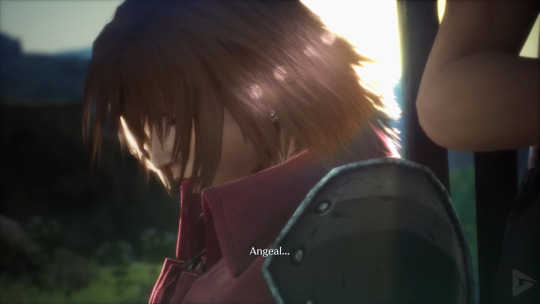
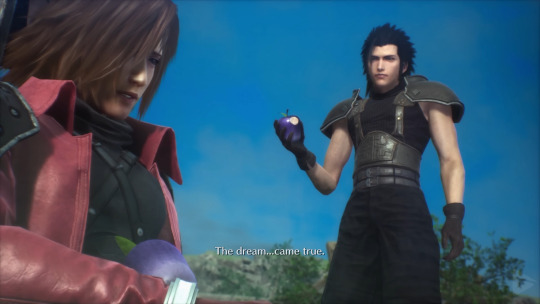
I find it interesting they intentionally draw parallels between Genesis & Angeal and Cloud & Tifa, people who have more explicit romantic feelings. I think Angeal and Genesis are supposed to represent a more “genuine” version of Cloud and Tifa’s relationship. Angeal represents the story cloud wanted to have throughout ffvii, having a childhood friend who never grew apart, who stayed together, and who followed a dream together. Angeal genuinely made soldier, and for a time he felt like he was in control of protecting others unlike Cloud. This contrast stays until the end, Cloud and Tifa learn to repair their relationship while Angeal and Genesis fall apart. Despite having everything Cloud wanted, it was not enough to sustain. This contrast is important in emphasizing that it is not about your background or your past, it is about what you do now and having people to fall back on. None of this is meant to be used as proof Genesis and Angeal are canon, but rather talk about Angeal's strong devotion and feelings for him since he was at least a teenager. They do not perfectly replicate the fall of mankind but it is interesting nonetheless. Here's to hoping we get to see more of how they interact in ever crisis.
#angeal hewley#genesis rhapsodos#final fantasy 7#final fantasy vii#crisis core#ffvii crisis core#ff7 crisis core#sorry this took so long executive dysfunction smile#removed link because I forgot tumblr hates that whatever
125 notes
·
View notes
Text
Headcannons about Apollo pt.1
PSA: This is mythology Apollo stuff but most of this applies to Percy Jackson Apollo as well.
Apollo loves no sibling more than Artemis, but he is closer to Athena. They bonded over being the favourite siblings, gods of knowledge/wisdom and the fact Athena was somewhat in charge of teaching/raising him when he first came to Olympus.
Apollo is the only other god besides Zeus to have the epithet ‘Moiragetes’ meaning ‘Leader of the Fates’. There are also only two moments of fate being averted in the entire mythos – once when Zeus swallows Metis and then again when Apollo tricks/convinces the Fates to extend Admetus’s lifespan. I imagine this means they are both capable of altering fate, it is just usually not worth the trouble.
Adding on to the previous hc, I also imagine Apollo has pure white eyes. As in, no pupils or irises. This is a trait I imagine the Fates share as well. Zeus would as well if he had gift of prophecy, but he doesn’t.
Apollo has the epithet ‘Lycegenes’ meaning ‘born of wolf’ or ‘born of Lycia’. Both work since his mother spent some time in a form of a wolf while pregnant in some versions and she is also a prominent goddess in Lycia. Lycia is in modern day Turkey, so I imagine Leto, Apollo and Artemis have some Turkish features. Specifically, they all have an aquiline nose (though you also see that in Greece), darker skin and (in the PJ universe aka the modern day) all three occasionally wear head scarfs. Not hijabs obviously since those are religious, but sheer fabric with a bunch of different designs relating to their sacred symbols wrapped around their head and hair.
Apollo was less of an older brother and more of a parent to Hermes, Dionysus and even Hebe when they were young. It was only once they were much older that Apollo started treating than more like siblings but will occasionally fall back into old habits.
Hera and Apollo have a better relationship than expected. They, along with Athena, mostly bonded over their shared woes of dealing with Zeus (who is not as bad as PJ Zeus but is still, you know, a king. And kings are rarely great.)
Apollo is the most all-knowing of the non-primordial gods. He has the domains of truth, prophecy and knowledge and, once he gains the sun in roman times, can also see anything that happens during the day. This makes him stupidly well informed. Even his cousin Hecate, Aunt Asteria, Grandmother Phoebe and Grandfather Koios are not as well informed since they only have the domain of prophecy and, even then, only have a specific kind while Apollo, seemingly, has access to every kind of prophecy.
Apollo (and Artemis) are Gods of Youth and, in Apollo’s case, he even has an epithet explicitly denoting him as an eternal child: ‘Acersecomes’ meaning one with unshorn hair. Boys in ancient Greece grew out their hair and generally cut and dedicated their hair to Apollo after reaching adulthood. As a result, Apollo not only has long curly golden hair, but is also unable to age any older than 15 since 16 was the age of adulthood back then. I imagine this would be the same for Artemis as well. (If we are including the PJ universe here, then they would be able to age up to 17).
68 notes
·
View notes
Text
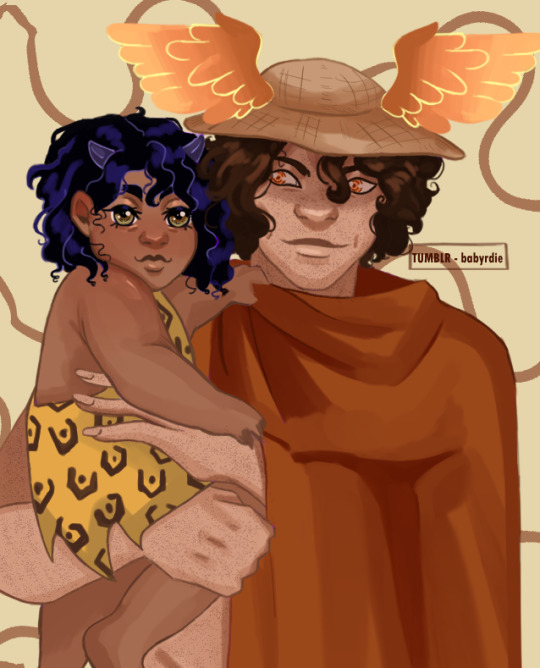
More Hermes here.
Based on the myth in which Zeus gives baby Dionysus to Hermes. Apparently, this event fits into one of those types of common myths, because surprisingly it has several sources and versions and is even an element also present in Roman mythology. I don't know why, but I didn't expect it to have as many variants as I found (or, at least, that such variants had come to us in such numbers), although I knew there was a famous statue showing this (and I discovered there was an amphora also). Anyway, I'm not basing it on any specific version, just the basic idea of Hermes having a role in being temporarily responsible for Dionysus.
Dionysus's design has already been explained previously, I just made him a baby. As a result, the horns are smaller and there is less detail. Maybe the next time I make him an adult his design will change, but it wasn't this time since he's a baby here.
As for Hermes, I used the idea of the winged petasus since it's a typical symbol of his and in this drawing you can't see it, but I will probably also keep the wings on his feet. I checked amphorae that had Hermes on them and noticed that it's common for him to be portrayed wearing a chlamys as it's an outfit often worn by travelers, so I drew him wearing one too. Like Dionysus, Hermes is both represented in a younger form (without a beard) and in an older form (with a beard). I decided to go with the younger version, because my first contact with him in ancient sources was when I read Homer and Homer described him like that, so that was the image I had of Hermes. In this drawing you can't see it because of the clothes, but I usually draw the body in the sketch before covering it and for Hermes I used Olympic runners as a reference to get an idea of a physique associated with speed.
149 notes
·
View notes